Buried on page 2 of Google search results? Hard pass. In fact, nobody wants that.
The Holy Grail is to be in 1st position, to attract the maximum number of clicks and traffic to your site. For that, there’s work to be done. You need — among other things — excellent content, backlinks, and… an SEO plugin that’s up to scratch.

Which one should you choose? To enlighten you, here’s a comparison between two of the most famous on the official directory: All in One SEO vs Yoast.
At the end of this article, you’ll know what they have in common and how they differ from each other in a number of areas: installation, interface, ease of use, content optimization, premium options, pricing, and so on.
You’ll also have all the information you need to decide which one best suits your needs… and whether you should use one of them on your site (rather than a competing plugin). 😉
Overview
- Overview of the two plugins
- Installing All in One SEO vs Yoast
- All in One vs. Yoast: Interface and ease of use
- Features of the two plugins
- All in One SEO vs Yoast: Content optimization
- Premium options and pricing of Yoast vs. All in One SEO
- Support and documentation
- All in One SEO vs Yoast: Our final opinion
Overview of the two plugins
Let’s start this All in One vs. Yoast comparison with a brief overview of the two plugins.
All in One SEO and Yoast are two freemium plugins designed to optimize the on-page SEO of a WordPress site.
Even in their free versions, they offer similar features to help you improve your search engine rankings:
- Configuration wizard to help you configure basic SEO settings
- Optimization of your hn tags (title and meta-description)
- Creation and management of XML and HTML sitemaps
- Design of a robots.txt file
- Integration of Schema.org markup
- Etc.
Nevertheless, each plugin has its own specific features, and there are differences between the two, which you’ll discover as we go along in this article.
What is All in One SEO?

All in One SEO (AIOSEO) is a historic SEO plugin. It was launched in 2007 as one of the pioneers in its field.
Today, it boasts 3M+ active installations, making it one of the industry giants in the official WordPress directory.
It’s also highly rated (4.7 stars out of 5) and presents itself as a “simple and powerful” SEO plugin, while being “the most user-friendly for beginners.”
AIOSEO — formerly known as All in One SEO Pack — is aimed primarily at beginners and non-technical users, and makes a promise to its future users:
Thanks to this plugin, you’ll be able to configure WordPress SEO correctly without “hiring an SEO expert or developer”.
Bought out by Awesome Motive in 2020 (WPBeginner, OptinMonster, WPForms, Smash Balloon, etc.), AIOSEO has undergone a major facelift in recent years, particularly in terms of the user interface and options on offer.
What is Yoast SEO?

With 5M+ active installations, Yoast SEO is the most popular SEO plugin in the official directory.
It’s a little younger than All in One SEO, having invaded the market in 2010. Once again, this is a highly rated plugin (4.8 stars out of 5).
Its mission, as stated on its presentation page on the official directory, is “to make SEO accessible to everyone.”
Like All in One SEO, it focuses on ease of use and simplicity, to appeal to a neophyte audience.
At the beginning of 2023, it refreshed its interface, making it cleaner and less austere.
So much for the introductions of our two acolytes. Without further ado, let’s turn to a new aspect of this All in One SEO vs. Yoast comparison: installation.
Installing All in One SEO vs Yoast
As soon as they are activated, each plugin offers a multi-step configuration wizard, designed to help you set up the plugin to suit your needs.
Installing All in One SEO
With All in One SEO, the configuration wizard is there to help you set the basic parameters “in less than 10 minutes.”
After use, I can confirm that the promise is kept. The plugin goes into a little more detail than Yoast, to help you configure your settings to best suit your type of site and your needs.
In detail, you’re invited to:
- Choose a category that best characterizes your website (blog, online store, news, etc.)
- Fill in the title and meta-description tags on your home page
- Provide information about your site and yourself (phone number, logo, social network profiles, etc.)
- Activate certain functionalities, such as a sitemap
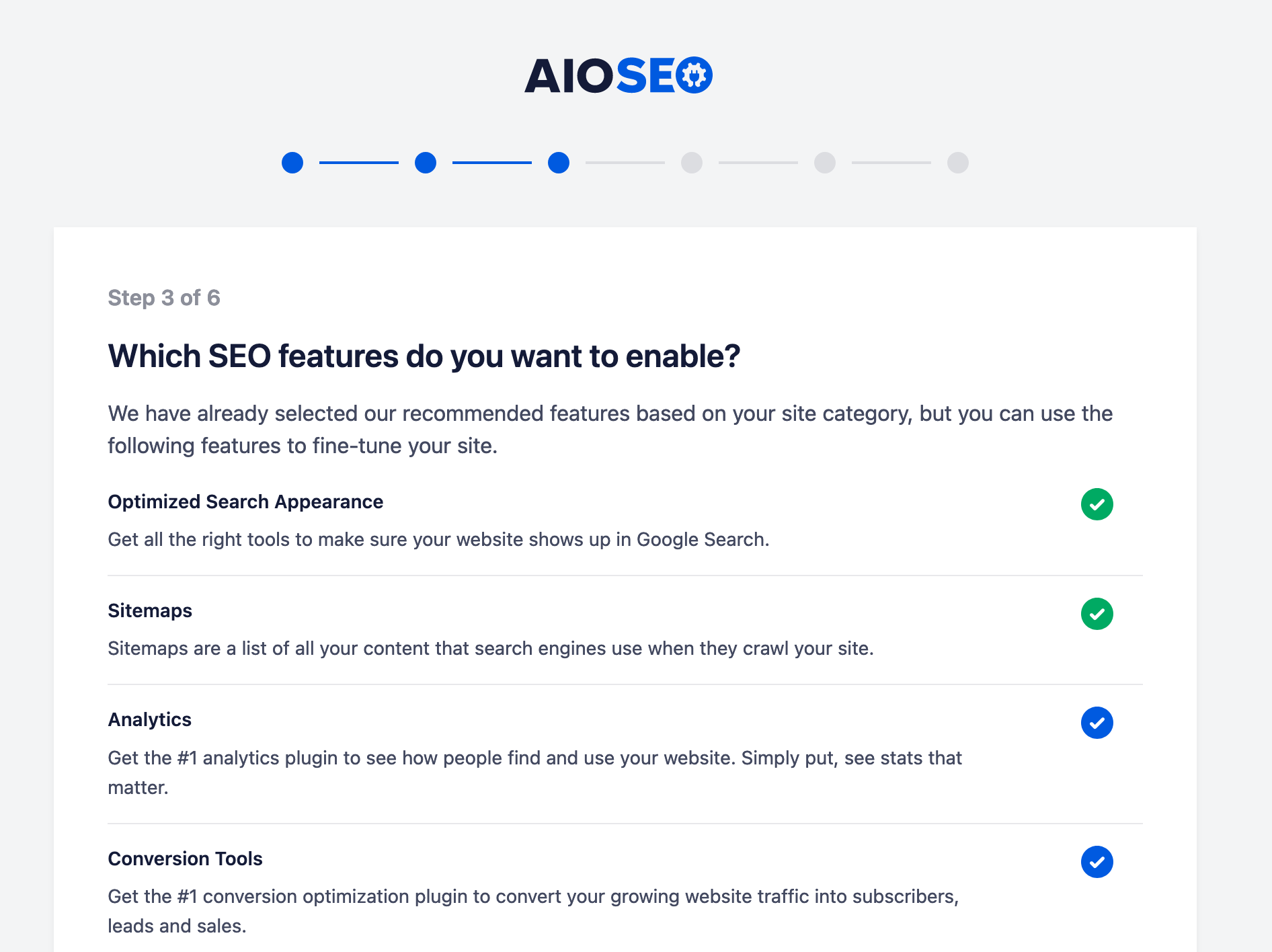
You are then dropped onto the plugin’s dashboard, which offers direct links to certain menus and provides you with an SEO audit score (with points for improvement).
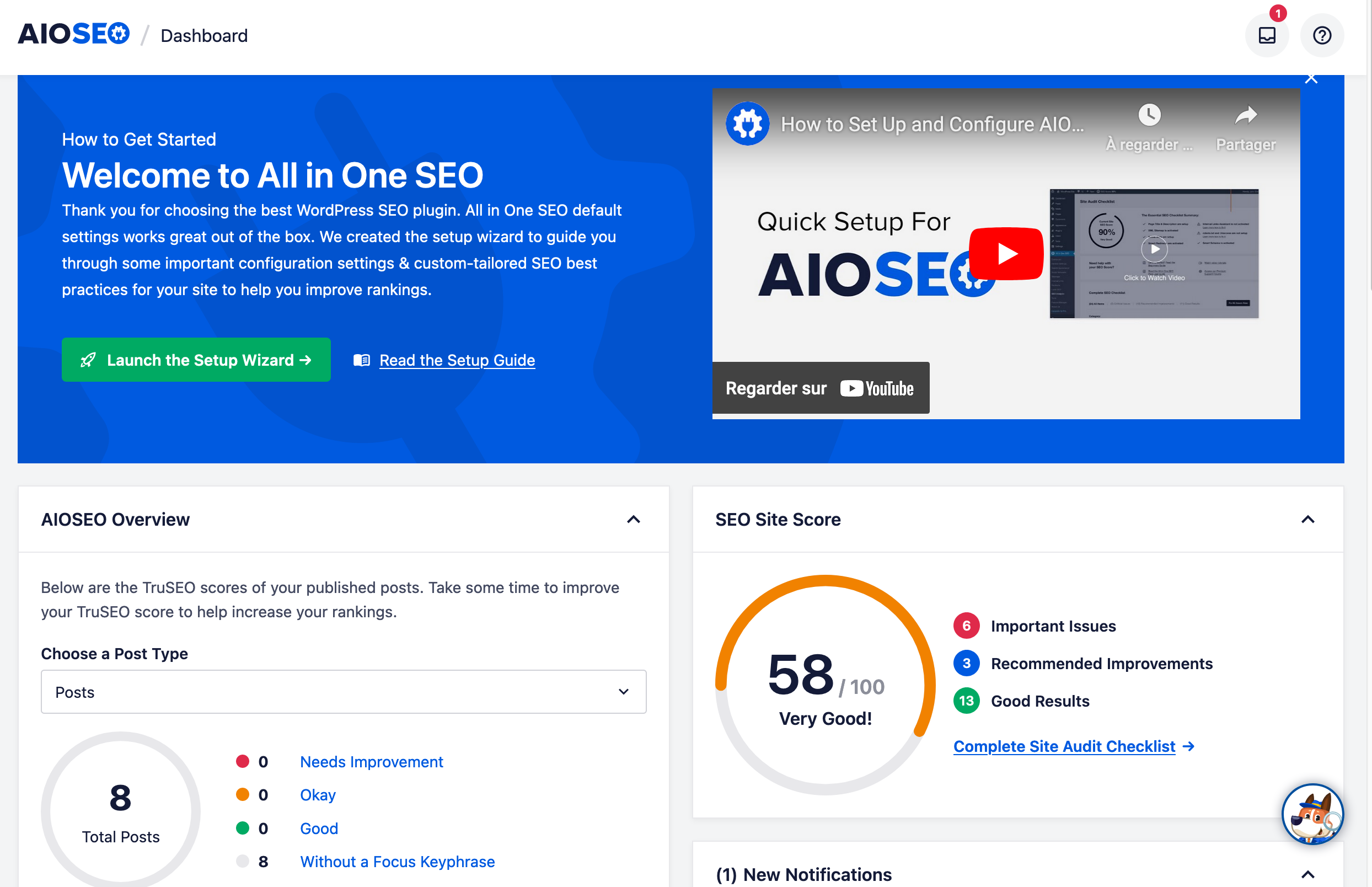
Installing Yoast
On the Yoast side, the setup wizard consists of 5 simple steps. The procedure is similar to that of All in One SEO. For example, you are asked to:
- Enter your site name and upload your logo
- Add your Facebook and Twitter accounts
- Indicate whether you want Yoast to have access to site usage tracking
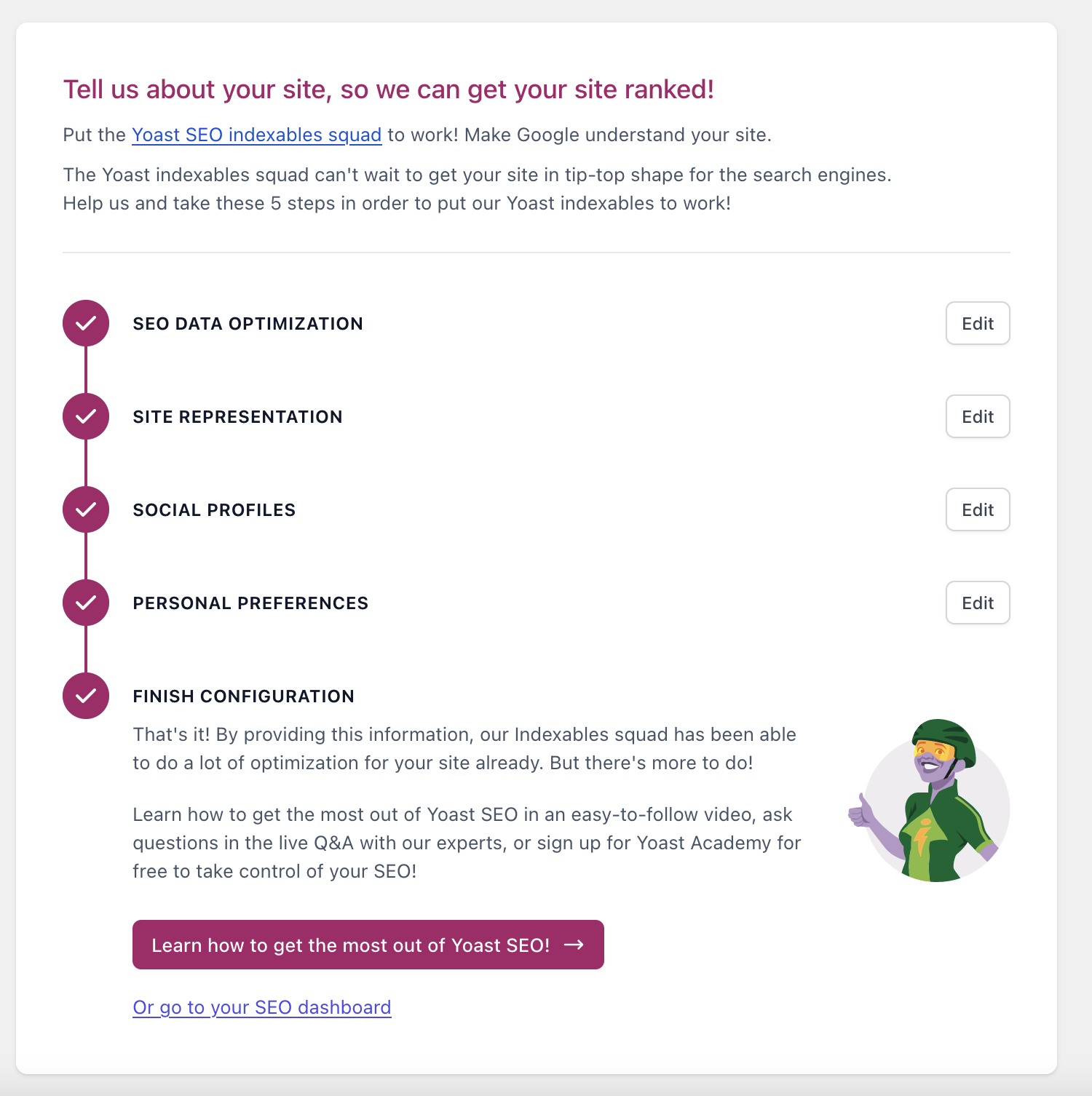
You then land on the Yoast dashboard and can access its interface via the Yoast SEO > Settings menu.
Let’s talk about this in the section just below.
Who’s winning here?
The All in One SEO vs Yoast battle is tied at the installation level. The logic is the same for both plugins, which choose to take the user by the hand and guide her through the basic parameters to be configured.
The process takes longer with All in One SEO, because the plugin goes into greater detail.
AIOSEO also offers a little extra: it detects the presence of another plugin (e.g. Yoast, Rank Math, or SEOPress) and offers to export your settings.
Do you want to learn how to optimize your WordPress site for SEO? Check out our comprehensive guide.
All in One vs. Yoast: Interface and ease of use
All in One SEO interface
All in One SEO offers access to its most important settings via quick links on the dashboard (search appearance, SEO analysis, sitemap, etc.).
For the rest, 15 menus are offered on your WordPress administration sidebar, which is quite a lot!

You’ll then find settings to make in each menu, via different tabs:
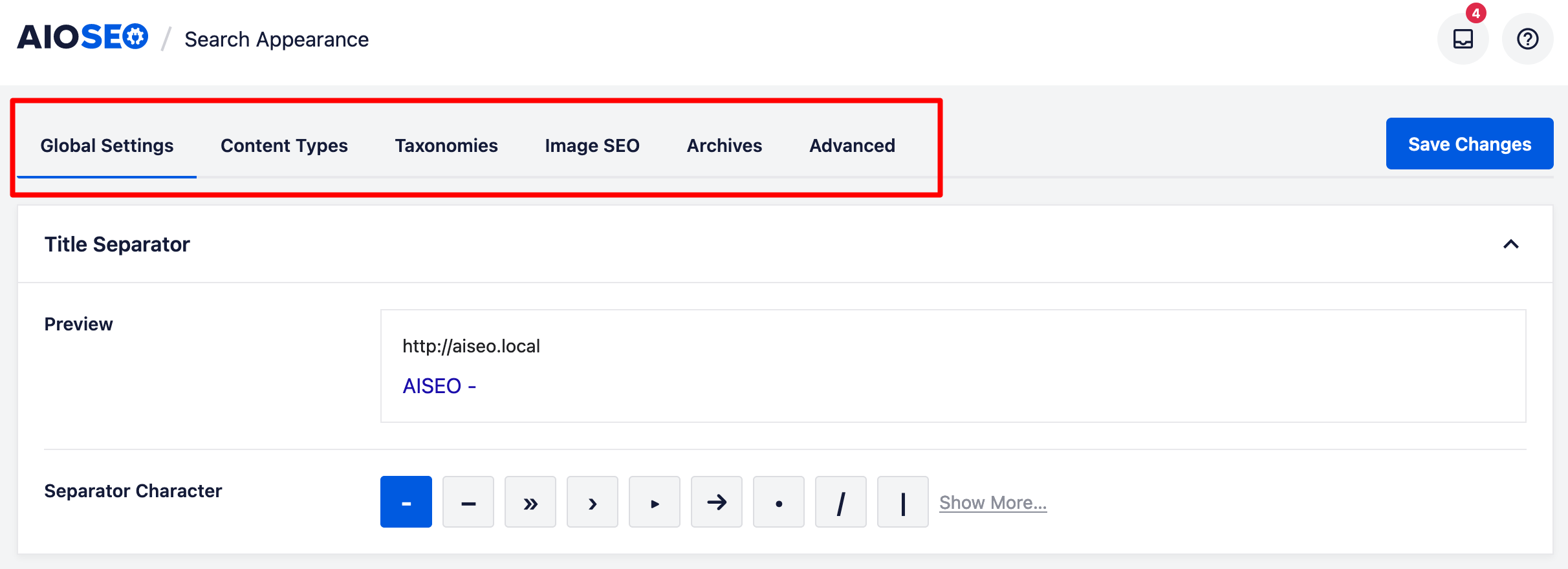
Yoast SEO interface
Just a few months ago, Yoast was lagging behind its competitor in terms of user interface (UI), which was rather austere and less user-friendly than that of All in One SEO.
The Yoast teams have rectified the situation, so to speak, by offering a new, refreshed interface in early 2023.
The rendering is much more polished and aesthetically pleasing. There are a number of key features in this interface:
- The vast majority of settings are grouped together in the Yoast > Settings menu. For the user, it’s simpler: you don’t have to leave the page and can set everything on the fly.
- You can activate/deactivate certain general functionalities (writing, site structure, social sharing, etc.) with a single click.
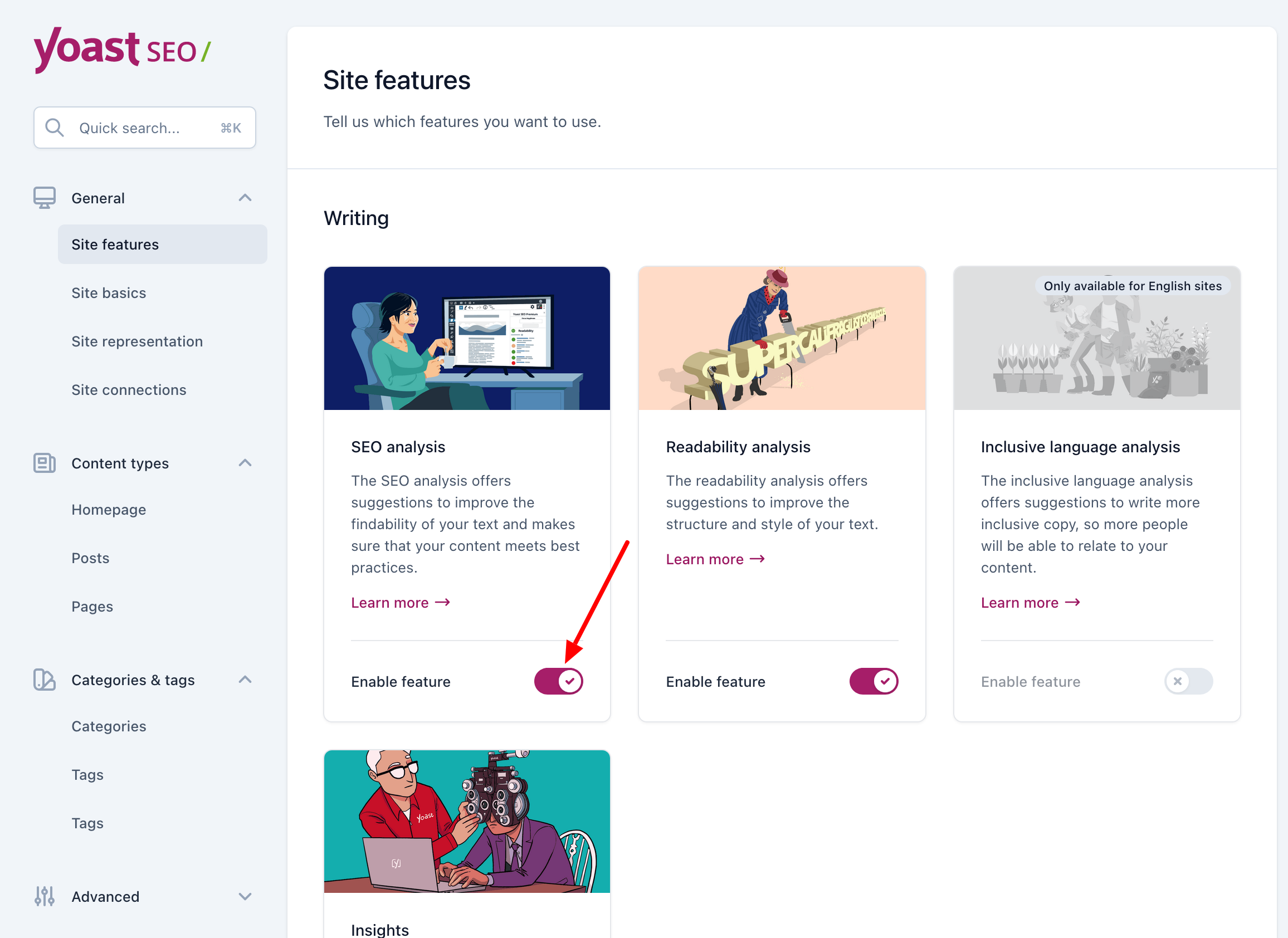
All in One SEO vs Yoast SEO: Who wins here?
In terms of interface and ease of use, I’d say Yoast has the edge in this All in One SEO vs Yoast SEO comparison.
Both plugins are easy to get used to, and each offers a clear, polished interface.
On the other hand, you can get lost in the settings offered by All in One SEO. There are options all over the place. So you’re more likely to feel like you’re drowning a bit when using AIOSEO than with Yoast, which has made the decision to group its essential settings together on a single page.
AIOSEO is also much more aggressive in terms of marketing, with multiple messages and other notifications urging you to upgrade to its premium version, which is a bit annoying.
Now for the third part of this All in One SEO vs Yoast test. Find it below.
Features of the two plugins
What can you do for free with All in One SEO?
As you’ve seen, All in One SEO doesn’t skimp on the options available to its users. From the free version, you’ll be able to do the following (non-exhaustive list):
- Perform an SEO audit to identify blocking factors and improve certain SEO points
- Optimize your content in terms of text and readability, thanks to a tool called TruSEO
- Integrate your site with social networks (Facebook, Twitter, Pinterest, YouTube, LinkedIn, Instagram, etc.) and webmaster tools (such as Google Search Console)
- Create an automatic XML sitemap and robots.txt file
- Configure a breadcrumb trail
- Manage the appearance of your content types on the search results page: title and meta-description tags for your posts, pages, categories, and other tags
What can I do with the free version of Yoast?
Sorry that this won’t sound very original, but Yoast offers pretty much the same thing as All in One SEO in terms of free features. So you can:
- Determine the appearance of your content types in search results and on social networks (posts, pages, and other taxonomies such as categories and tags)
- Integrate your site with Schema.org to increase your chances of getting enriched results, helping search engines to understand your content
- Connect your site to various webmaster tools
- Configure the appearance of your archives (author, date, format, etc.)
Who wins here?
At first glance, it’s hard to detect any major differences between these two plugins in terms of free features.
However, if you dig a little deeper, you’ll find that All in One SEO goes a little further than Yoast on certain settings. It’s a little more comprehensive on some points:
- It provides an SEO score for your site (a kind of audit), highlighting problems encountered and suggesting areas for improvement:
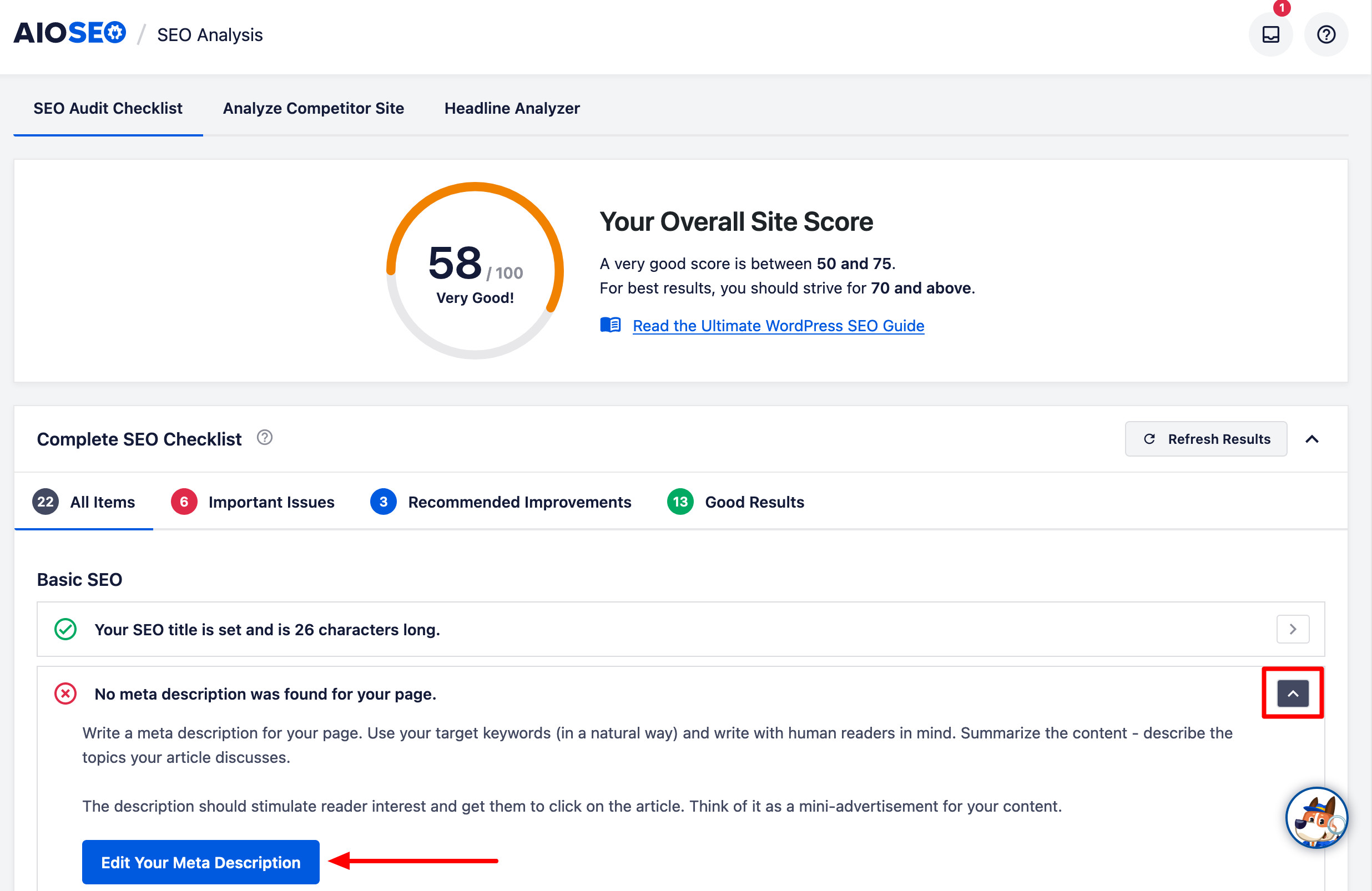
- It goes further in customizing your title and meta-description tags, offering more variables than Yoast
- Its sitemap and robots.txt customization features are more extensive and intuitive than those of Yoast. Yoast simply activates them for you, but you have no control over the type of data to include/exclude, for example.
AIOSEO offers numerous options in this area, for greater user control:
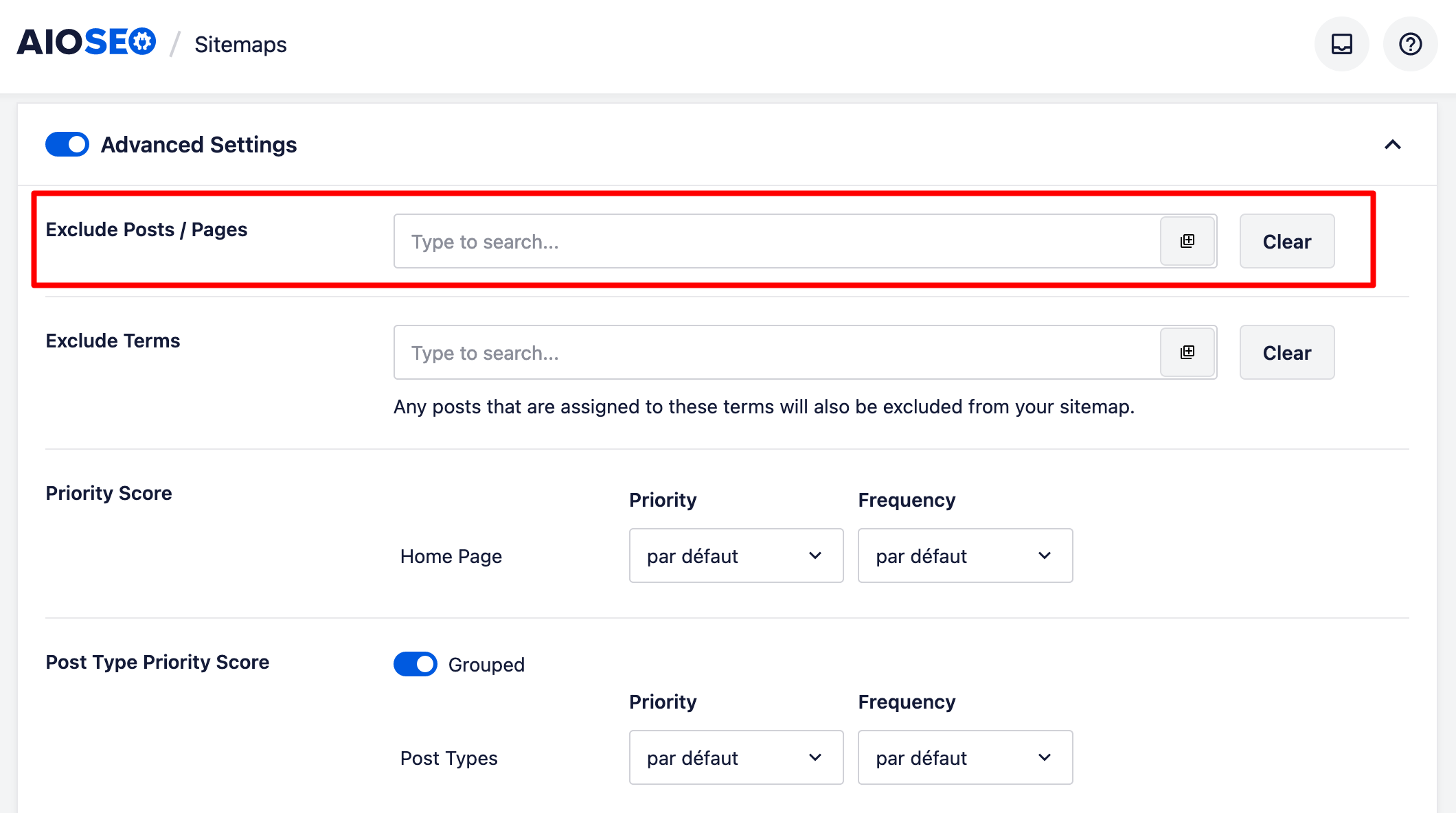
All in One SEO vs Yoast: Content optimization
Let’s turn now to a crucial aspect of any self-respecting SEO plugin: its content optimization options.
With All in One SEO, as with Yoast, everything takes place in the WordPress content editor. To find out more, create or modify a post or a page.
The meta box
For both plugins, you’ll find a meta box at the bottom of your page. The meta box is organized in tabs, allowing you to edit the following elements for each plugin:
- Modify your title and meta-description tags, with the option of previewing their display on Google’s search results page
- Customize the appearance of your publication when shared on social networks (Facebook and Twitter)
- Automatic generation of Schema.org markup. This is only possible with AIOSEO’s premium version, whereas Yoast allows you to select a content type corresponding to your post or page.
- On-page SEO management, with the display of problems and optimizations to be carried out. Each plugin is color-coded (red, orange, and green) to let you know what’s working and what needs to be corrected.
- The readability of your page (paragraph length, use of passive voice, subheadings, etc.)
- In addition, All in One SEO offers tabs for managing links and redirects on your content, but only in one of its premium packages.
Here’s a quick comparison of the appearance of the two meta boxes between All in One SEO vs Yoast SEO:
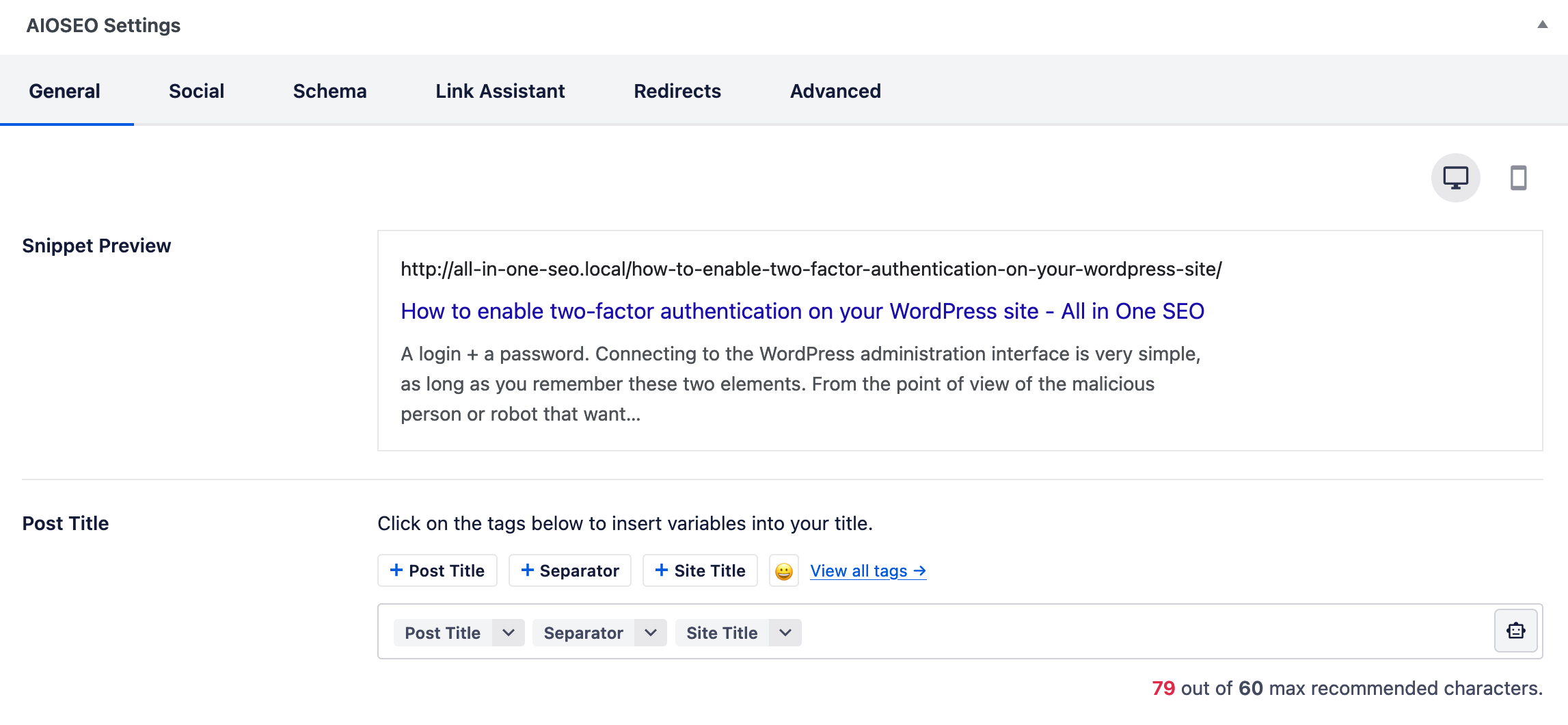
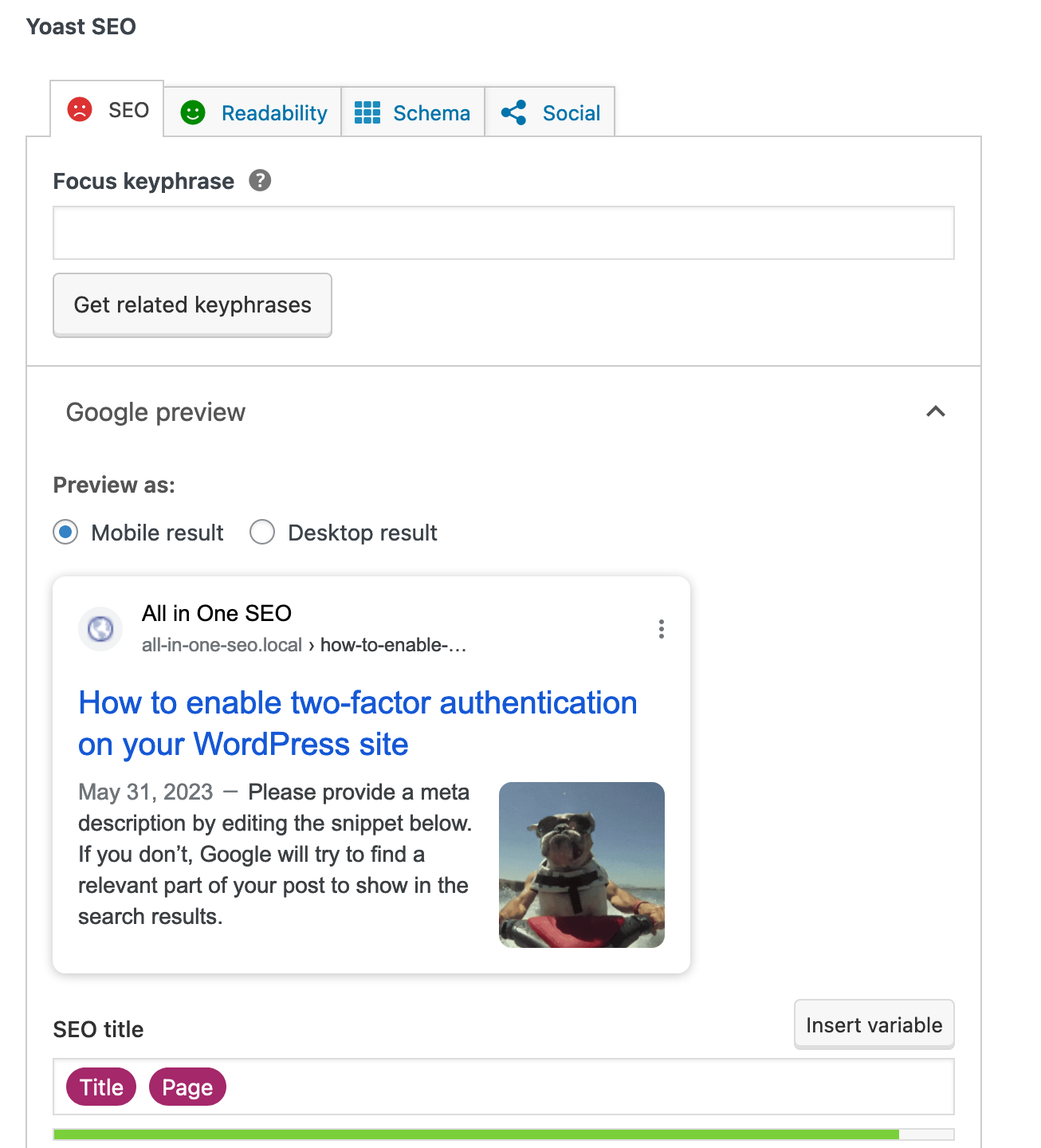
Options also accessible from the content editor toolbar
For the rest, note the following:
- All in One SEO offers a Headline Analyzer, with a score (out of 100) for your publication and suggestions for improving it.
- AIOSEO offers an overall score (out of 100), while Yoast doesn’t give a rating and uses traffic lights to tell you what’s working and what’s not (a green light means the optimization is OK, a red or orange light means there are things to rectify).
- Each plugin allows you to modify its settings directly from the content editor toolbar:
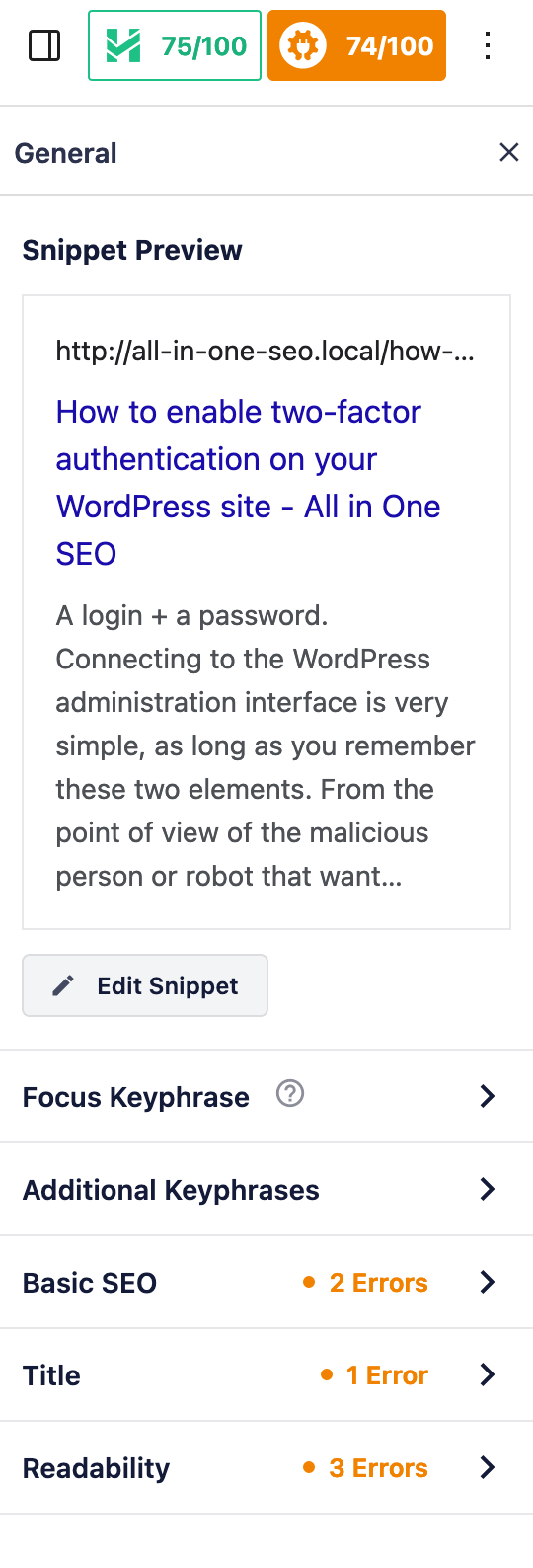
Page analysis and readability
In terms of the options offered by the two plugins, let’s take a closer look at SEO analysis and readability, two important elements for optimizing your content.
As mentioned earlier in this All in One SEO vs. Yoast comparison, All in One SEO and Yoast are quite similar in terms of the options they offer.
In terms of presentation, Yoast has chosen to separate SEO analysis and readability into two tabs, whereas AIOSEO has grouped everything together in its “General” tab. Here you’ll find both basic SEO analysis and readability analysis:
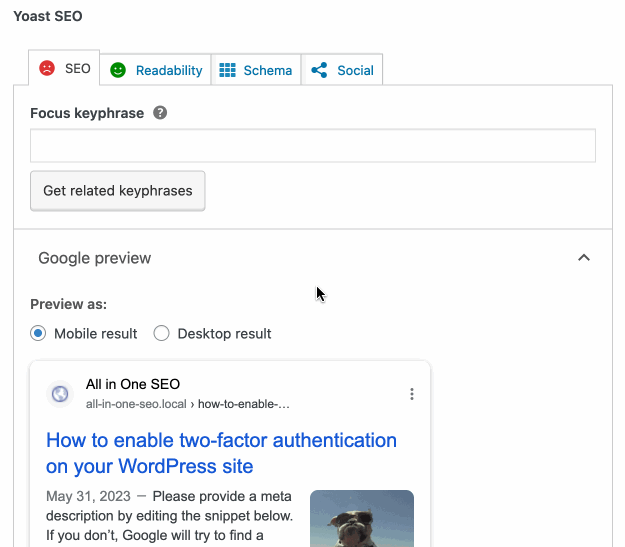
So much for the presentation in terms of display. In terms of included options, there’s no noticeable difference.
Each plugin tells you what’s good (green for AIOSEO, green light for Yoast) and what needs improving (orange or red), particularly in terms of the placement of your main keyword in strategic places:
- In the URL
- In the introduction
- In the title and meta-description tags
And don’t forget keyword density (repetition throughout the text) and the proper use of links (internal and external).
The same goes for readability, with a little extra from Yoast: you can quickly identify the location of a point to be improved in your text, by clicking on an eye-shaped icon:
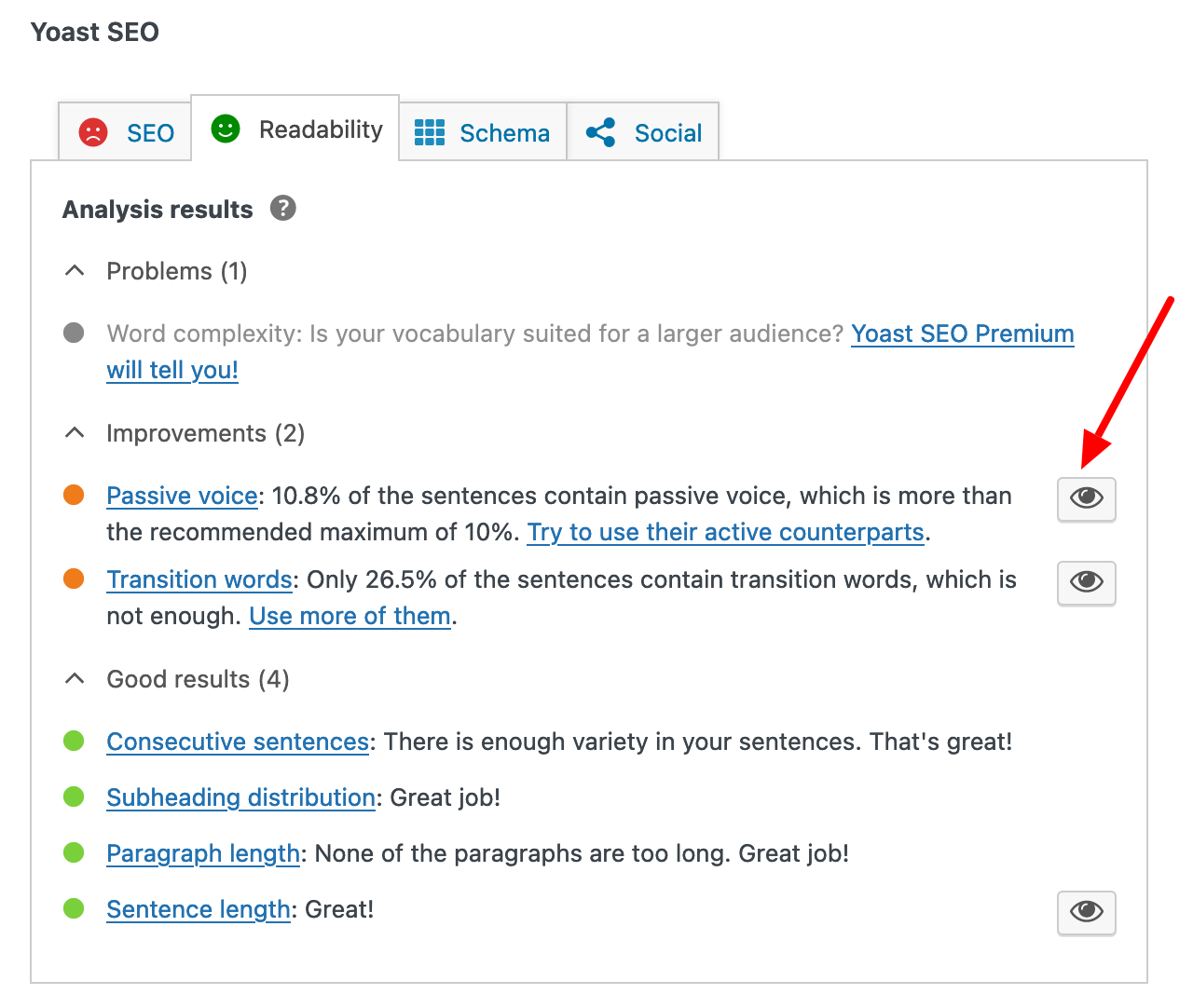
Yoast also offers a slightly more advanced readability analysis than AIOSEO, giving you a little more explanatory detail.
Schema tagging
Let’s move on to Schema.org markup. This structured data format is used in particular to display rich snippets on search engine results pages.
Although it’s a complex format to understand, the two plugins have chosen to take you by the hand by automatically generating it for you, if need be.
However, All in One SEO does not generate Schema markup unless you use one of its premium versions.
Social networks
On the social networking front, it’s a toss-up between All in One SEO and Yoast. With each plugin, you can write a customized title and meta-description for content that will be shared on Facebook and Twitter.
Note that All in One SEO has slightly more advanced options than Yoast here, since you can, for example, choose the source of the image to be shared, or include the URL of a video.
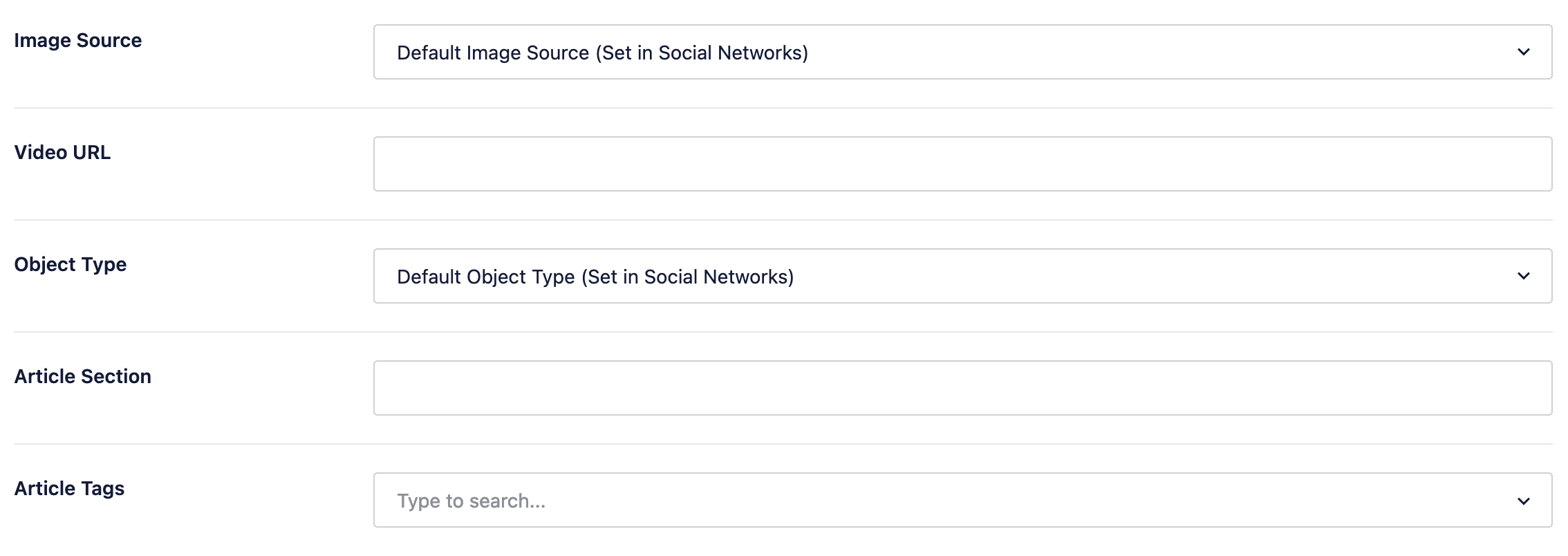
And above all, you can preview the display of your posts shared on social networks, which Yoast only offers in its premium version.
All in One SEO vs Yoast: Who wins here?
A draw. It’s hard to pick a winner here between All in One SEO and Yoast. It’s fair to say that AIOSEO offers a few more options than its competitor (e.g. title analyzer and a preview of your content shared on social networks).
I find Yoast’s readability analysis to be a little more precise.
So far, we’ve focused on the free versions of both plugins. Now let’s take a look at what they offer their premium users, as well as their pricing policy.
Premium options and pricing of Yoast vs. All in One SEO
All in One SEO premium offer
Here are some of the options offered by All in One SEO via its premium licenses:
- Access to an artificial intelligence (AI) tool to automatically create your title and meta-description tags, directly on the WordPress content editor interface
- A Schema markup generator
- A tool for managing internal links, with suggested links and display of orphaned publications
- Management of redirects and 404 errors
- Video and news sitemaps
- IndexNow protocol integration for immediate notification to search engines of changes to your content
- Management of the SEO of your images
- Customization of your breadcrumb trail, with access to personalized templates
- Advanced support for WooCommerce to optimize your pages and product categories
- Keyword tracking
- User access control
- Etc.
All in One SEO offers 4 licenses, ranging from $49.60/year to $299.60/year (for use on up to 100 sites).
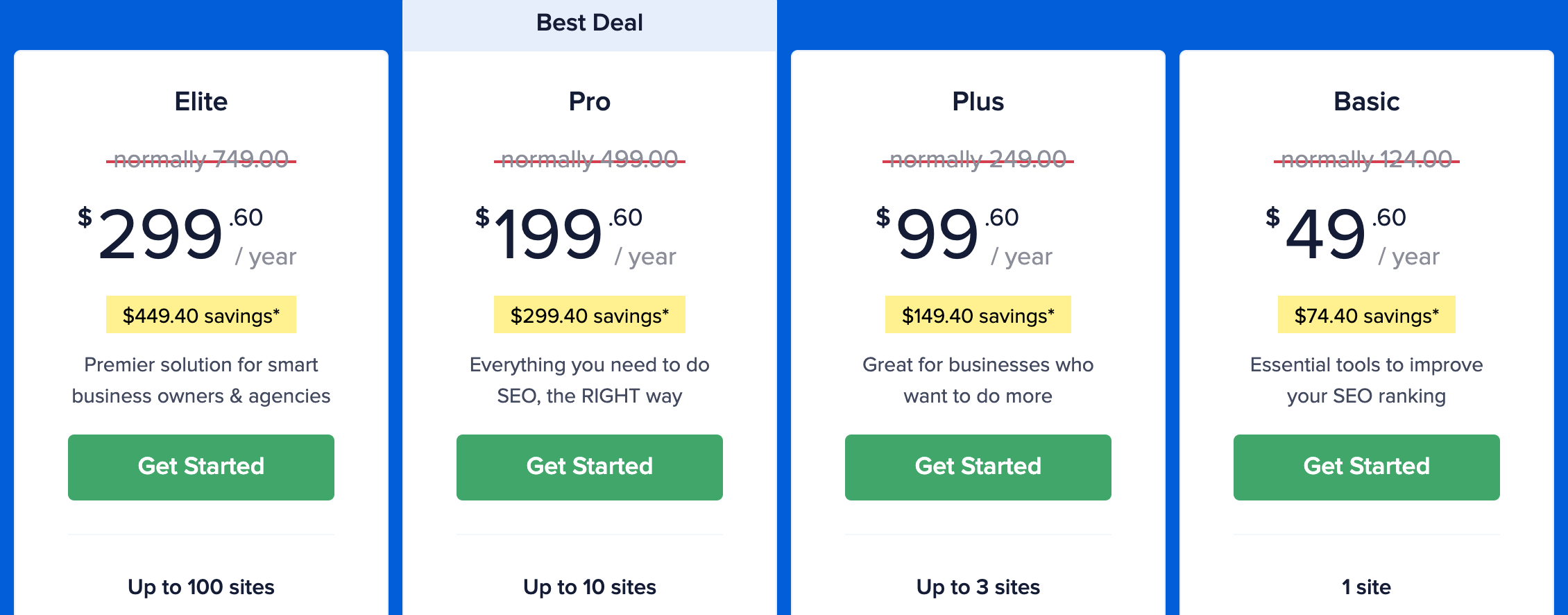
Not every license gives you access to all the premium features, so you need to know exactly what your needs are before deciding. Most premium features come in the form of modules, which you activate on a case-by-case basis.
Yoast SEO Premium
If you’re interested in Yoast SEO Premium, here’s a non-exhaustive list of the options you’ll benefit from:
- An automatic redirection manager
- A tool to strengthen your internal links (with suggestions, for example), and an orphan content detector (content that has no internal links pointing to it)
- An even more advanced content analysis tool than the free version
- The possibility of adding variations and synonyms of your main keyword to obtain semantically related suggestions and integrate them into your content
- Preview of your publications on Facebook and Twitter
- Access to all Yoast Academy training courses, with around ten SEO-related courses of varying technical content (eCommerce SEO, SEO copywriting, local SEO, international SEO, etc.)
Yoast’s offer is not very clear
In terms of offerings and pricing, it’s a little less clear-cut than All in One SEO. Yoast offers various options:
- You can purchase its premium plugin for $99/year. Usage is limited to one site. If you want to use it on several sites at the same time, Yoast offers a sliding scale of charges, but very lightly. For example, the rate will be $841.50/year for use on 10 sites (instead of $990/year).
- 4 targeted premium plugins, each priced at $79/year, for use on 1 site (Video SEO, Local SEO, News SEO, and Yoast WooCommerce SEO).
- A bundle package containing Yoast Premium and the 4 plugins listed above for $229/year for use on one site.
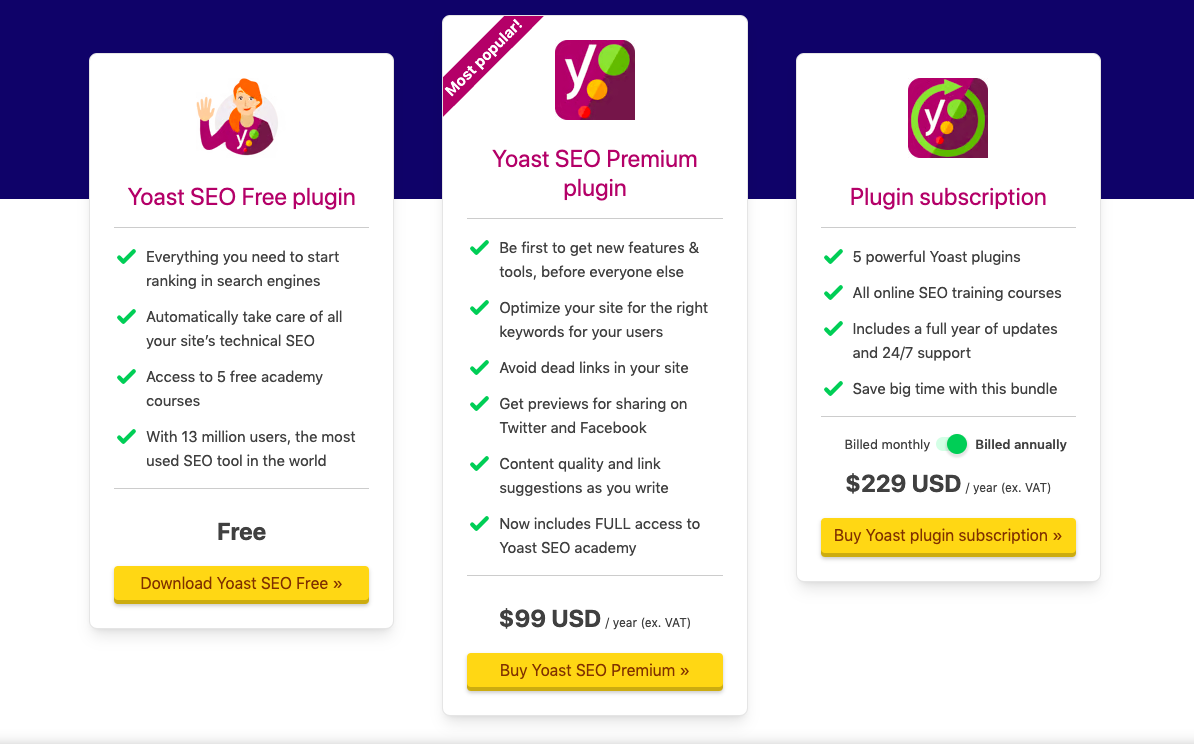
You’ll need to take a close look at the range of options on offer to see how much this could cost you.
If you just want to take advantage of a redirect manager and a tool to strengthen your internal links on one site only, Yoast will be more advantageous as it offers both these options in its premium plugin ($99/year).
With AIOSEO, you’ll need at least the Pro license ($199.60/year) to benefit from these services.
On the other hand, if you want to take advantage of advanced WooCommerce and local SEO options (to name but a few), while needing to activate the plugin of your choice on multiple sites, All in One SEO will be much more advantageous.
Its highest license, which includes all its options, costs $299.60/year for use on up to 100 sites.
If you want to take advantage of similar Yoast options, while activating it on a large number of sites, you’ll have to go for the bundle package offered at $229/year. But at that price, you’ll only be able to use it on one site.
If you want to install it on client sites, the bill could be very high.
Yoast is therefore more expensive overall if you want to use it on several sites. The winner (in terms of the most advantageous rate) therefore depends on your specific needs.
Support and documentation
The penultimate step in our All in One SEO vs Yoast comparison is the question of support. Neither plugin offers direct, personalized support in its free version. However, this is available via their premium offer.
In this respect, the two plugins are on an equal footing. On the other hand, Yoast SEO stands out from the crowd thanks to the many resources it offers its users:
- A public forum
- A comprehensive blog filled with articles on a wide range of SEO topics
- The Yoast SEO Academy with courses and webinars on SEO and WordPress
- Documentation for developers
At All in One SEO, you also have access to a technical blog (though less extensive than at Yoast). On the other hand, the documentation is more succinct, though sufficient to help you out on your own in some cases.
All in One SEO vs Yoast: Who wins here?
While both plugins have available documentation, Yoast SEO offers more resources for its users.
Still hanging with me? It’s time to conclude by telling you who the two plugins are primarily aimed at.
All in One SEO vs Yoast: Our final opinion
Yoast vs All in One SEO: Which plugin for which user?
In terms of interface, functionality, and ease of use, there’s a strong correspondence between All in One SEO and Yoast.
The two plugins are very similar and box in the same category. First and foremost, I’d say they’re both primarily aimed at beginners.
After that, the choice between one or the other depends on your needs and personal preferences (desired options, number of sites on which you want to activate the plugin, etc.).
While it’s true that All in One SEO offers users a few more options in its free version, I also find that you get a little more lost in the middle of its various settings menus than with Yoast, which has chosen to group almost everything together on a single page.
Finding your way around will therefore take a little longer, but that’s not the end of the world either.
Which one should you choose?
All in One SEO vs Yoast: which plugin should you choose? First of all, I’d say that their free version is enough to get you started with SEO optimization of your content.
In that case, my choice would be Yoast, which I find less confusing in terms of options. However, AIOSEO is also an effective and valid choice, especially if you’re not a fan of Yoast’s interface. 😉
On the other hand, if you have more advanced needs and want to purchase one of the premium versions of one of the plugins, AIOSEO will be more advantageous if you want to use it on several sites at once.
Finally, if you’re a more advanced WordPress user looking for a comprehensive yet inexpensive SEO plugin, I’d recommend giving Rank Math or SEOPress a try, rather than All in One SEO.
But that’s just my opinion. I’d be delighted to hear yours, so don’t hesitate to give me your feedback in the comments area.

Receive the next posts for free and access exclusive resources. More than 20,000 people have done it, why not you?






Continue reading
Articles posted in WordPress PluginsSpectra: Dive into this page builder that’s integrated into the WordPress editor
Leaving the native WordPress interface? Never. Drowning you in a slew of widgets? He wouldn’t dream of it. With this guy, blocks are the guiding light. Create your next WordPress site without leaving the default editor (Gutenberg), without coding, and…
WP Rocket: We went over this plugin with a fine-tooth comb [2024 Review]
It took me a while, but I finally found it. Yes, I found someone who dared to criticize the WP Rocket plugin sharply. What a nerve! This reader of an American site specializing in WordPress, says that this plugin has…
Yoast SEO: a guide to set up the best SEO plugin for WordPress
With more than 620 million downloads at the time of writing, Yoast SEO is one of the 10 most downloaded plugins of all time. Officially, it’s installed on websites in order to optimize their SEO (Search Engine Optimization). Put another…